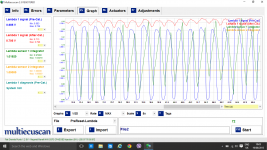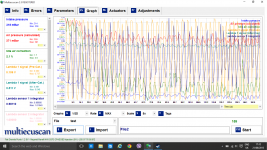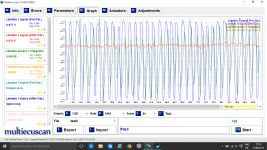Hi guys,
I have some issues relating to performance, and the LPG service garage noticed a constant juggling between lean and rich mixture and advised me to have it checked out.
The car is a 2009 Grande Punto 1.2 8V Petrol converted to LPG.
So now I did the following:
1) Connected MultiEcuScan.
2) Plotted a graph of:
--- Lambda 1 signal (Pre-Cat.)
--- Lambda 1 signal (After-Cat.)
--- Lambda sensor 1 integrator
--- Lambda sensor 2 integrator
--- Lambda 1 diagnosis (Pre-Cat.) (this is not plottable)
3) Did a 'self-adaptation parameters' reset and a 'phone wheel learn' reset.
4) Plotted the same graph as point 2 above.
I noticed that the 'Lambda 1 diagnosis (Pre-Cat.)' reading constantly switches between lean and rich every ~1.5 seconds which is not good from what I can understand.
Some background information: The car was converted to LPG after-market. Recently I noticed that the LPG injectors going into the intake manifold are connected a bit wonky and they're held in place only with some metal glue. Could it be that excess air is going inside the intake manifold due to this, and the car ECU is caught in an infinite loop trying to correct this?
You can find the screenshots attached.
If anyone can help in understanding these lambda graphs please, I would be grateful.
Thanks
Edit: Forgot to mention, the readings are taken on Petrol not LPG.
I have some issues relating to performance, and the LPG service garage noticed a constant juggling between lean and rich mixture and advised me to have it checked out.
The car is a 2009 Grande Punto 1.2 8V Petrol converted to LPG.
So now I did the following:
1) Connected MultiEcuScan.
2) Plotted a graph of:
--- Lambda 1 signal (Pre-Cat.)
--- Lambda 1 signal (After-Cat.)
--- Lambda sensor 1 integrator
--- Lambda sensor 2 integrator
--- Lambda 1 diagnosis (Pre-Cat.) (this is not plottable)
3) Did a 'self-adaptation parameters' reset and a 'phone wheel learn' reset.
4) Plotted the same graph as point 2 above.
I noticed that the 'Lambda 1 diagnosis (Pre-Cat.)' reading constantly switches between lean and rich every ~1.5 seconds which is not good from what I can understand.
Some background information: The car was converted to LPG after-market. Recently I noticed that the LPG injectors going into the intake manifold are connected a bit wonky and they're held in place only with some metal glue. Could it be that excess air is going inside the intake manifold due to this, and the car ECU is caught in an infinite loop trying to correct this?
You can find the screenshots attached.
If anyone can help in understanding these lambda graphs please, I would be grateful.
Thanks
Edit: Forgot to mention, the readings are taken on Petrol not LPG.
Attachments
Last edited:





